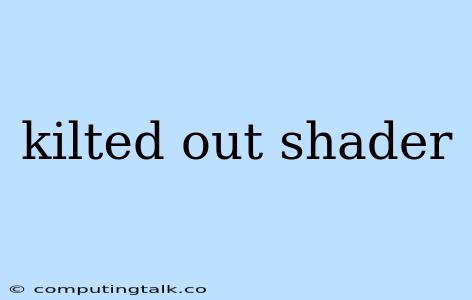Kilted Out Shader: A Deep Dive into a Powerful Technique
The world of shaders is vast and constantly evolving, offering endless possibilities for creating stunning visual effects. Among the many techniques available, kilted out shaders stand out as a particularly effective method for achieving unique and visually captivating results.
This article explores the concept of kilted out shaders and their applications, providing a comprehensive guide to understanding and implementing this powerful technique. We'll delve into the fundamental principles, explore practical examples, and discuss the benefits and potential drawbacks of using kilted out shaders.
What are Kilted Out Shaders?
Kilted out shaders are a type of shader that utilizes a specific pattern or texture to create a distinctive visual effect resembling a kilt, the traditional garment worn by men in Scotland. The "kilting" process involves layering and overlapping different patterns or textures to achieve a unique, layered look.
The key element of a kilted out shader is the use of a repeating pattern, often a plaid or tartan, to generate the visual effect. This pattern is then manipulated through various shader operations, such as:
- Blending: Different patterns are combined using blending techniques to create a more complex and visually interesting result.
- Displacement: The pattern can be used to displace the surface geometry, creating a three-dimensional effect.
- Coloring: The pattern can be used to color the surface, adding visual interest and variation.
- Animation: The pattern can be animated to create dynamic and visually engaging effects.
How to Create a Kilted Out Shader
Creating a kilted out shader typically involves the following steps:
- Choose a base pattern: Select a repeating pattern, such as a plaid or tartan, that will be the basis of your kilted out shader.
- Apply the pattern to the surface: Apply the chosen pattern to the surface you want to manipulate.
- Apply shader operations: Use shader operations like blending, displacement, coloring, or animation to achieve the desired visual effect.
- Experiment and refine: Play around with different parameters and techniques to find the best combination for your desired outcome.
Practical Examples of Kilted Out Shaders
Kilted out shaders can be used in a wide range of applications, including:
- Creating unique materials: You can create realistic-looking fabrics like tartan cloth, or even more abstract materials with a "kilted" appearance.
- Designing procedural textures: Kilted out shaders can generate complex and visually appealing procedural textures for various applications.
- Adding visual interest to surfaces: You can use kilted out shaders to add texture and depth to any surface, making it more interesting and engaging.
- Generating patterns: You can use kilted out shaders to generate a variety of repeating patterns, which can be used for various purposes.
- Creating stylized art: Kilted out shaders can be used to create unique and stylized art pieces, adding a distinctive touch to your creations.
Benefits of Kilted Out Shaders
Kilted out shaders offer several advantages:
- Visual appeal: The distinctive look created by kilted out shaders can be highly appealing and add visual interest to any project.
- Versatility: Kilted out shaders can be applied to a wide range of surfaces and materials, making them a versatile tool for artists and designers.
- Customization: Kilted out shaders offer a high degree of customization, allowing you to fine-tune the visual effect to your exact requirements.
- Procedural generation: Kilted out shaders can generate complex patterns and textures procedurally, eliminating the need for manually creating and editing textures.
Drawbacks of Kilted Out Shaders
While kilted out shaders offer numerous benefits, there are also some potential drawbacks:
- Computational cost: Complex kilted out shaders can require significant computational resources, which can impact performance, especially on older or less powerful hardware.
- Learning curve: Understanding and implementing kilted out shaders requires a certain level of knowledge and experience with shaders and programming.
- Limited real-world applicability: Kilted out shaders, while visually appealing, may not be suitable for all real-world applications, such as photorealistic rendering.
Conclusion
Kilted out shaders are a powerful and versatile technique that offers unique visual possibilities. By utilizing repeating patterns and various shader operations, you can create distinctive and visually engaging effects. While there are some potential drawbacks, the benefits of kilted out shaders far outweigh the limitations, making them a valuable tool for artists, designers, and game developers.
Experimenting with different patterns, parameters, and shader operations will allow you to unlock the full potential of this technique and create captivating visual experiences.
